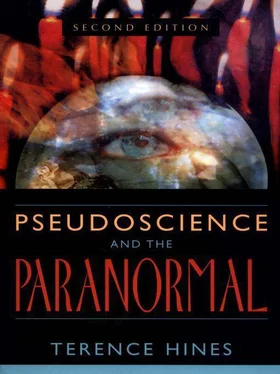Does the fact that the skeptic cannot pinpoint the methodological errors in each and every experiment supporting the existence of N rays mean that the existence of the rays should be accepted? Of course not. The general explanation for the favorable results—such as reliance on subjective measures—along with the failure of well-designed studies to validate the existence of N rays is more than enough to justify the conclusion that N rays do not exist. Unlike proponents of pseudoscientific claims, science places the burden of proof on the individuals who make extraordinary claims. Blondlot and his colleagues failed to provide valid evidence for the existence of N rays.
Polywater, initially known as anomalous water, was “discovered” in the early 1960s by a Russian scientist named Nikdlai Fedyakin, working at a laboratory about one hundred miles from Moscow. This form of water had several extremely strange qualities. It boiled at a temperature well above water’s normal boiling point and froze at a point well below water’s normal freezing point. Further, polywater was said to be a more stable form of the H 2O molecule. This led to at least one scientist making the dire prediction that, if even the smallest amount of polywater was allowed to contaminate natural water supplies, natural water molecules would spontaneously change into the more stable polywater form, thus ending all life on earth due to the radically different characteristics of polywater. (Readers familiar with the work of Kurt Vonnegut Jr. will recognize at once the similarity between polywater and the mythical substance “ice nine” created in Vonnegut’s story “Cat’s Cradle.”)
Russian research on polywater quickly moved from the provinces to a prestigious laboratory in Moscow. At first polywater attracted little attention in Western scientific circles. When it did, however, there was an explosion of papers on the topic in numerous scientific journals. Between 1962 and 1975 several hundred papers on polywater appeared.
For various technical reasons, polywater could be produced only in minute quantities inside sealed glass tubes with equally minute diameters. The debate over the existence of polywater turned on one crucial point—whether the water produced in these tubes was pure H 2O, or whether it was impure, the impurities leaching out of the glass and changing the properties of the pure water. Proponents of polywater claimed they had produced pure polywater, with no impurities. That is, the substance was pure H 2O in a new and different molecular configuration. Skeptics who tried to produce polywater in their laboratories consistently ended up with nothing more than impure water of the normal molecular configuration. The proponents responded that the reason the skeptics couldn’t produce true polywater was that they hadn’t learned how to do it just right. While such a rejoinder was appropriate at first, it quickly became little more than a nonfalsifiable hypothesis that proponents used to explain away every failure by the skeptics to produce “true” polywater.
As the 1960s faded into the 1970s, it became clear that polywater did not exist and claims for its reality were, in fact, based on impure water, as the skeptics had argued from the first. By the mid-1970s polywater was a dead issue.
The similarities between the N-ray and polywater episodes are instructive. One striking similarity was the use by proponents of both phenomena of nonfalsifiable hypotheses in the defense of their claims. Thus, such techniques for defending untenable claims are not limited to pseudosciences and the paranormal. They appear in legitimate science in those—happily rather rare—situations where commitment to the reality of a certain phenomenon is stronger than the data on which that commitment is based. The much more common use of nonfalsifiable hypotheses in pseudosciences and the paranormal is due simply to the near-total lack of real phenomena in these areas to begin with.
As was the case with N rays, it would probably be impossible to pinpoint the exact procedural errors made in every experiment that seemed to produce evidence of polywater. We know, of course, the general nature of the errors made, but that is different from an exact explanation for every case on record. However, as in the case of N rays (and as will be noted again in the chapters on UFOs and ESP), it is not necessary for the skeptic to explain away every seemingly positive instance of a claimed phenomenon before rejecting the phenomenon. In the polywater case, as well as in the case of N rays, the total failure of careful experimentation to turn up evidence for the reality of the phenomenon, combined with a general explanation for what went wrong, was more than sufficient for scientists to reject the existence of the phenomenon.
The same principle of rejecting a finding even if no scientific flaw can be found in the experiment, on the ground that the result cannot be replicated, is universal in science. Science is littered with experiments reporting some particular result that, upon later attempts, fails to replicate.
A personal example makes the point. My master’s thesis (Hines 1976) examined a particular question in the field of hemispheric asymmetries in the human brain. In one of the experiments, I obtained the results that I predicted. I was quite excited by this. Then I went back and tried to replicate the findings. Two replications failed. To this day I have no idea why the initial experiment succeeded in providing the anticipated results. However, the two failures to replicate, along with similar failures that were later reported in the literature, convinced me that the initial positive result was incorrect.
In the cases of N Rays and polywater, one can not specify the exact date on which these aberrations came to the attention of the scientific community, much less the public at large. Such is not the case with cold fusion, the final scientific mistake to be considered here. On Thursday, March 23, 1989, chemists Stanley Pons and Martin Fleischmann held a news conference at the University of Utah that was widely covered on the national news programs that evening. They announced that they had discovered a method for producing nuclear fusion using simple equipment at room temperature. The term “cold fusion” was immediately coined to describe this phenomenon. Over the next few years great controversy raged over whether or not cold fusion was real or illusory. The history of the controversy has been examined in detail in three books (Close 1991; Huizenga 1992; Taubes 1993). Of the three, that by Gary Taubes’s is probably the most comprehensive. Rothman (1989–90) has published an article-length summary.
Nuclear fusion occurs when atomic nuclei are brought so close together that they stick to each other. The mass of the stuck-together nuclei is less than that of the separate individual nuclei. The “extra” mass is converted into energy, with the amount of energy determined by Einstein’s famous equation E = mc 2, where E is energy, m is mass, and c is the speed of light. Since c 2is a huge number, even a very small mass, such as that of atomic nuclei, will result in the release of a great amount of energy.
If this was all there was to it, fusion would be easy. However, in order to get atomic nuclei close enough to actually fuse, the natural repulsive force that exists between nuclei when they are brought close together must be overcome. This takes a huge amount of energy. The conventional method of achieving fusion is to use heat on the order of hundreds of millions of degrees to sufficiently speed up the nuclei so that the repulsive forces will be overcome. Needless to say, this is both difficult and expensive. Still, since fusion would be a relatively clean source of energy (it produces little of the radioactive waste that nuclear fission does), it has been the object of considerable research funds. Given the clean nature of fusion energy and the great expense of obtaining it using the conventional superheated methods, one can understand how attractive a method would be for obtaining this sort energy using cheap apparatus at room temperature. This is exactly what Pons and Fleischmann claimed to have done at their news conference.
Читать дальше












